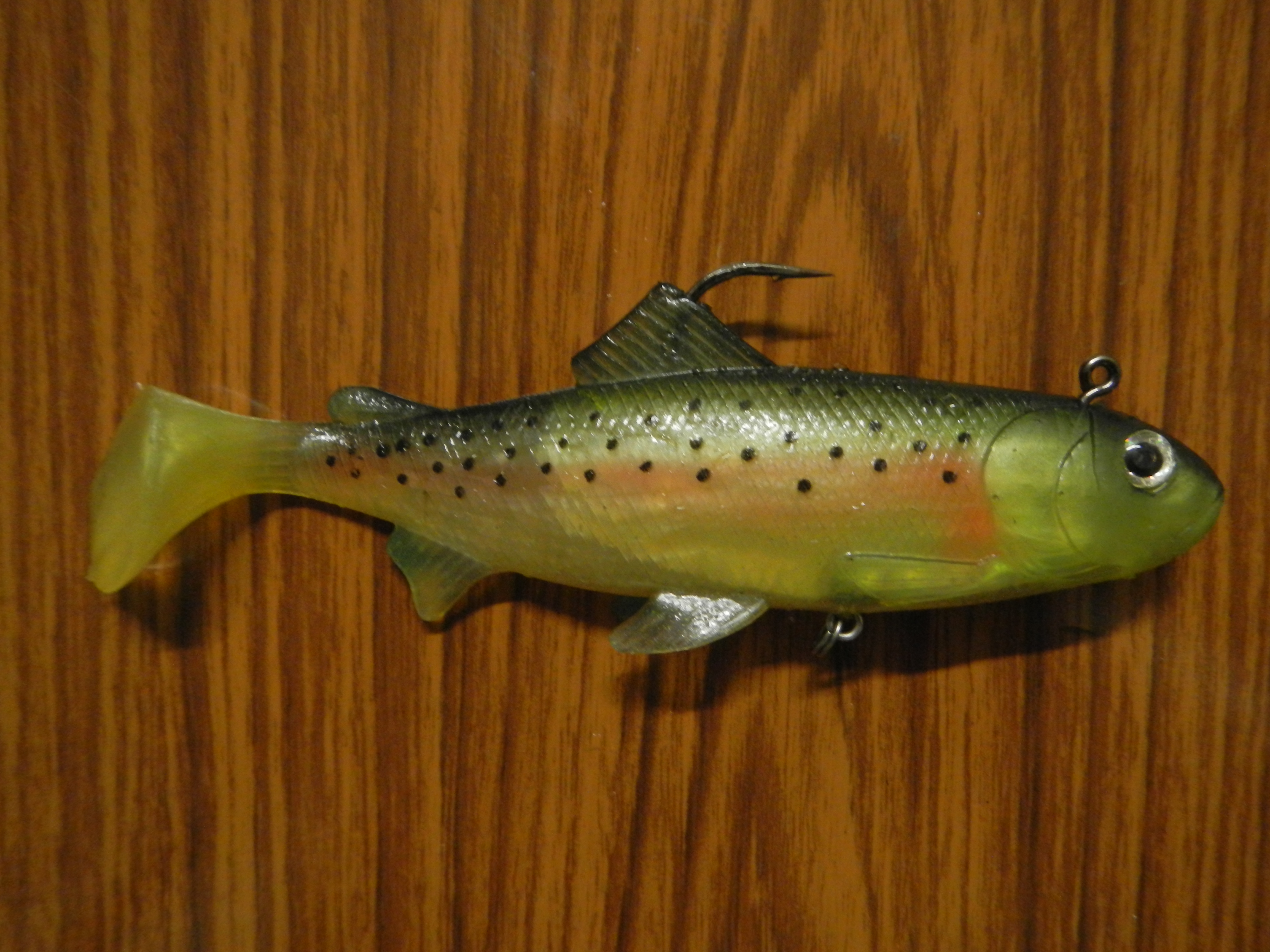swimbait on:
[Wikipedia]
[Google]
[Amazon]
 Swimbaits or swimmers are a loosely defined class of fishing lures that are designed to primarily imitate the underwater swimming motions of baitfishes.
Swimbaits or swimmers are a loosely defined class of fishing lures that are designed to primarily imitate the underwater swimming motions of baitfishes.
File:Rainbow_Trout_Swimbait.JPG, A swimbait designed to imitate a
'Top Ten Swimbait Picks in my Box'
- TheWiredAngler article with images {{fisheries and fishing Fishing equipment
History
Swimbaits originated in the late 1980s as lures designed to imitaterainbow trout
The rainbow trout (''Oncorhynchus mykiss'') is a species of trout native to cold-water tributary, tributaries of the Pacific Ocean in North America and Asia. The steelhead (sometimes called steelhead trout) is an Fish migration#Classification, ...
in Southern California
Southern California (commonly shortened to SoCal) is a geographic and Cultural area, cultural List of regions of California, region that generally comprises the southern portion of the U.S. state of California. Its densely populated coastal reg ...
reservoir
A reservoir (; ) is an enlarged lake behind a dam, usually built to water storage, store fresh water, often doubling for hydroelectric power generation.
Reservoirs are created by controlling a watercourse that drains an existing body of wa ...
s that largemouth bass and striped bass
The striped bass (''Morone saxatilis''), also called the Atlantic striped bass, striper, linesider, rock, or rockfish, is an anadromous perciform fish of the family Moronidae found primarily along the Atlantic coast of North America. It has ...
fed on. They were larger and more lifelike imitations than most available mass-produced lures at the time.
Types
Swimbaits are mainly broken down into 2 categories: hard body and soft body swimbaits.Hard-body
Hard-body swimbaits are often made of eitherwood
Wood is a structural tissue/material found as xylem in the stems and roots of trees and other woody plants. It is an organic materiala natural composite of cellulosic fibers that are strong in tension and embedded in a matrix of lignin t ...
or plastic
Plastics are a wide range of synthetic polymers, synthetic or Semisynthesis, semisynthetic materials composed primarily of Polymer, polymers. Their defining characteristic, Plasticity (physics), plasticity, allows them to be Injection moulding ...
. These baits are designed to mimic baitfish that predatory fish—such as largemouth bass, smallmouth bass, spotted bass, pike, and trout
Trout (: trout) is a generic common name for numerous species of carnivorous freshwater ray-finned fishes belonging to the genera '' Oncorhynchus'', ''Salmo'' and ''Salvelinus'', all of which are members of the subfamily Salmoninae in the ...
—would eat.
Hard-body swimbaits are built to produce a swimming action that provokes a predatory instinct, causing fish to strike. The lure's movement depends on the number of joints in its design.
Glide Baits (Single-Joint Swimbaits)
A single-jointed hard-body swimbait, commonly known as a glide bait, moves with a serpentine or "gliding" action in the water. This bait can be retrieved at different speeds and with various techniques to create erratic movements that mimic injured fish.Multi-Jointed Swimbaits
Due to their segmented body design, multi-jointed hard-body swimbaits offer a more natural swimming motion. These baits can also create unique movements based on retrieve styles and speeds. The versatility of hard-body swimbaits makes them effective in various fishing conditions, from clear open water to heavy cover, depending on how they are retrieved.Soft-body
Soft-body swimbaits are almost exclusively made out ofrubber
Rubber, also called India rubber, latex, Amazonian rubber, ''caucho'', or ''caoutchouc'', as initially produced, consists of polymers of the organic compound isoprene, with minor impurities of other organic compounds.
Types of polyisoprene ...
or soft plastic, similar to artificial worms. Some soft-body swimbaits are designed to trigger strikes based on movement, while highly detailed baits (usually top-hook) rely more on realism than action.
Soft-body swimbaits have several subcategories, including paddle tails, line-through swimbaits, and top-hook swimbaits.
Paddle Tail Swimbait
Paddle tail swimbaits are the most common type used by many anglers. These baits come in various sizes: * Smaller paddle tails are often used as trailers for a spinnerbait, chatterbait, or underspin. * Larger paddle tails are commonly fished on a swimbait jig head or a weighted extra-wide gap (EWG) hook. Paddle tail swimbaits come in two styles: - Solid-body paddle tails provide durability and are often paired with jig heads. - Hollow-body paddle tails allow different rigging options and internal weight systems.Line-Through Swimbaits
Line-through swimbaits are large swimbaits that allow the fishing line to run through the body. This design helps prevent fish from using the bait as leverage to throw the hook.Top-Hook Swimbaits
Top-hook swimbaits have a large, strong, jig-style hook that protrudes from the top of the swimbait. These swimbaits are often used in deep water or rocky environments where bottom-dwelling fish are present. The top-hook swimbait typically has a wedge-style tail, which is designed for colder water conditions, providing a more subtle swimming action.Gallery
rainbow trout
The rainbow trout (''Oncorhynchus mykiss'') is a species of trout native to cold-water tributary, tributaries of the Pacific Ocean in North America and Asia. The steelhead (sometimes called steelhead trout) is an Fish migration#Classification, ...
.
File:Kanan_fishing_lures,_swim_baits.jpg, Various swimbaits from Kanan Fishing Lures.
File:Lingcod_with_swim_bait.png, A Lingcod caught with a swimbait.
References
External links
'Top Ten Swimbait Picks in my Box'
- TheWiredAngler article with images {{fisheries and fishing Fishing equipment